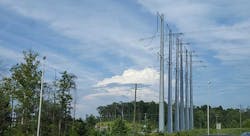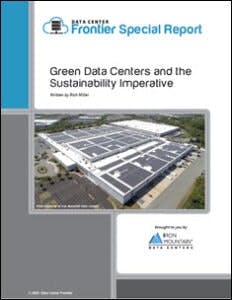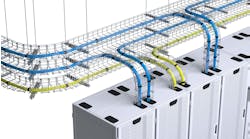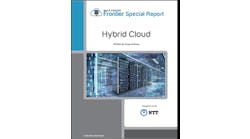The Power of the Negawatt: Efficiency Improves Data Centers’ Energy Impact
Last week, we launched a special report series on data centers and sustainability by taking a look at the role of green data centers in a future hazy with the inevitable impacts of climate change. Below, we take a step further by exploring the evolution of data center efficiency, as well as how the data center industry is looking to source renewable energy.
Get the full report.
Electricity is the lifeblood of any data center, which is why the industry consumes enormous amounts of power.
The global data center industry used approximately 205 terawatt hours (TWh) in 2018, representing about 1% of the world’s electricity use that year, according to a paper by leading energy researchers.
That sounds like a lot, and it is. That’s why data centers are routinely characterized as “energy hogs” by media and environmental groups.
The larger story is that data centers have dramatically improved their energy efficiency, resulting in a small increase in industry electricity use during a period of explosive growth for cloud computing and online services. Server farms have become remarkably efficient in their energy use.
Electricity usage by global data centers grew just 6% from 2010-18 (from 194 TWh to 205 Twh). During that time, the installed base of physical servers rose 30%, the number of data center compute instances (i.e. virtual machines running on physical hardware) rose by 550%. Meanwhile, data center IP traffic rose 11-fold, and installed storage capacity rose 26-fold.
This extraordinary progress illustrates the power of the “negawatt” — the energy that is saved by operating more efficiently.
Best Practices, PUE Bring Better Efficiency
The data center industry’s sustainability journey history highlights the two key steps toward a green economy: Reducing total power use, and ensuring that the power used comes from renewable sources (wind, energy, hydro) rather than fossil fuels.
Data center operators began the process by focusing on the factors they could control within their own organizations, especially energy efficiency. The data center was slow to focus on energy efficiency from 2000 to 2005, reflected in 90% growth in data center energy use during that period. Things improved between 2005 and 2010, with energy usage rising just 24%, due to an improved emphasis on best practices as well as the economic slowdown.
A pivotal shift occurred in 2007-2009, when data center providers began sharing best practices in industry forums and conferences, a major change from the secrecy that once surrounded data center operations. This period saw the founding of The Green Grid, an industry consortium focused on energy efficiency, as well as a decision by hyperscale pioneer Google to share its closely-held efficiency secrets with the industry.
By sharing these best practices, hyperscale players brought improved energy efficiency to multi-tenant data centers, which extended these benefits to their customers. These efficiency gains grew along with the service provider industry. 451 Research estimates that global MTDC power capacity grew 62.4% in the five years through 2019, a compound annual growth rate of nearly 10.2%.
Hear from Data Center Frontier’s Rich Miller and Iron Mountain experts on data center sustainability in an upcoming WEBINAR — to be held Wednesday, Feb. 10. Register Today.
There’s an old saying that you “can’t manage what you can’t measure.” Prior to 2010, relatively few data centers had sensors to track energy and water usage and environmental conditions (like temperature and humidity) throughout their environment. As more facilities became instrumented, it allowed more meaningful use of efficiency metrics developed by industry groups, especially Power Usage Effectiveness (PUE), a leading “green” metric developed by The Green Grid.
PUE dropped by 25% from 2010 to 2018, while the energy intensity of the global data center industry) Expressed as energy use per compute instance) dropped by around 20% per year between 2010 and 2018.
The sharing of best practices has been pivotal in allowing the broader industry to embrace the innovations of the world’s most sophisticated technology companies.
Beyond Efficiency: Sourcing Renewable Energy
Global corporate purchasers of renewable energy in 2019. (Source: IEA)
Cloud computing has emerged as a surprising force for the commercialization of renewable energy at Internet scale, with Google, Amazon, Microsoft, Apple and Switch sourcing renewable energy to power their cloud data centers. This usually happens through utility-scale power purchase agreements (PPAs), with hyperscale operators buying the output of generators of solar and wind power, bringing new renewable energy onto the grids supporting their data centers.
The International Energy Agency found that the four largest purchasers of renewable energy in 2019 were all data center operators, including the three major cloud computing platforms along with the leading social network. Data center specialist QTS Realty was not far behind in the sixth position.
The depth of the data center industry’s impact on purchases of solar and wind power is even greater in the United States, In the U.S. Environmental Protection Agency’s most recent Top 100 list of the largest users of renewable power for calendar year 2018, tech firms dominated the top of the list, occupying five of the top 6 positions, and 11 of the top 25.
Top U.S. users of renewable energy for 2018. (Source U.S. Environmental Protection Agency)
A number of other large data center operators don’t participate in the EPA’s data collection, but have had their PPA activity documented by the Renewable Energy Buyers Alliance (REBA) Deal Tracker, which reveals that Facebook and Amazon were among the largest buyers of renewable energy in 2019.
REBA noted two positive trends—larger purchases of wind and solar energy by the leading players, as well as broader participation in renewable energy markets.
“The continued growth of the large-scale energy buyer led procurement of renewable energy, as well as a surge of first-time buyers accounting for more than half of transactions, contributes to REBA’s overall goal to catalyze 60 GW of renewable energy by 2025.”
Electricity usage by global data centers grew just 6% from 2010-18, while physical servers rose 30% and compute instances rose by 550%.
Matching a company’s entire data center energy use with renewable energy purchases can be challenging, but several companies have reached this milestone, including Iron Mountain Data Centers, which also operates a 7 megawatt solar array on the roof of its New Jersey data center. Switch says it has also matched 100% of energy use with renewables, and recently broke ground on a 555-megawatt solar generation facility in Nevada.
As data centers have become larger players in power markets, they have begun adopting sophisticated strategies to provision green power and manage the pricing and risk profile of its energy. This includes the use of third parties to craft virtual power purchase agreements to buy capacity through liquid marketplaces.
Energy brokers from Citi cited three tools that can be used to procure renewable energy at scale:
- As-Generated Power Purchase Agreements (PPAs) These agreements, which have been used by Google, Amazon, Microsoft and Facebook, allow users to buy generation capacity from a renewable energy project for a fixed price and fixed term. The primary challenges involve managing intermittency risk and power price fluctuations.
- Wholesale Block Hedges These tools fix the price on a portion of a customer’s energy use, using a tradeable contract in a liquid market with counterparties. This approach also has challenges in managing variability and risk, but less than PPAs.
- Intermediation Structures These are custom agreements in which users work with a market maker like Citi or retail energy provider to create vehicles to funnel power to end user.
The data center industry’s growing clout in the power markets comes with increased exposure to the complex economics of power in the United States, where utilities operate under a variety of business models and regulatory oversight, and prices fluctuate widely based on geography and weather trends.
The Amazon wind far in Texas that helps provide green energy for the AWS Xlous. (Photo: Jordan Stead/ Amazon)
That’s why three of the largest players — Google, Apple and Amazon — have gained approval from the Federal Regulatory Energy Commission (FERC) to buy and sell electricity in energy markets.
Some of the largest financial players in the data center sector are also stepping up their investment in energy generation, and looking for opportunities to integrate more renewable energy sources into their power mix, including more on-site and adjacent power generation.
Global operator NTT and infrastructure funds Macquarie Infrastructure Partners (which controls Aligned and Netrality) and Stonepeak Infrastructure Partners (Cologix) are among those hoping to deploy new power generation infrastructure to support their data center footprints.
Last year NTT founded NTT Anode Energy to create distributed systems bringing together telecom and data center infrastructure with advanced electric supply systems that integrate renewable energy, battery storage, and microgrids. NTT Global Data Centers operates in the US through its RagingWire portfolio.
This report continues next week with a review of how data centers are helping to build a greener tomorrow. And catch up on the first energy in the series here to learn more about green data centers and “our cloudy future.”
Download the full report, Green Data Centers and The Sustainability Imperative, courtesy of Iron Mountain, to explore how climate change and a greening of data centers is changing the industry.







